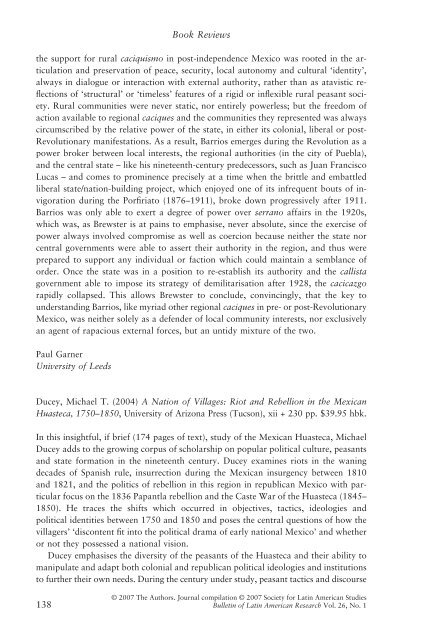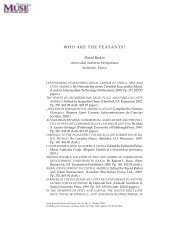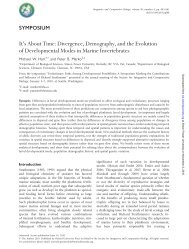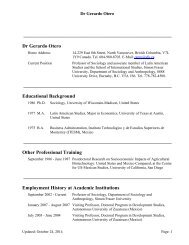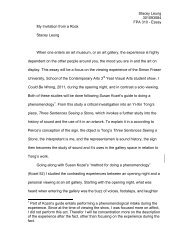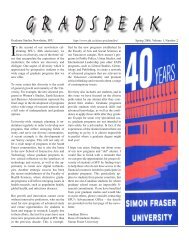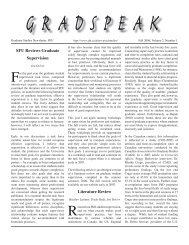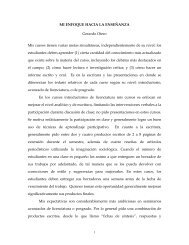Review of Mexico in Transition by Byron Crites
Review of Mexico in Transition by Byron Crites
Review of Mexico in Transition by Byron Crites
- TAGS
- transition
- byron
- crites
- cgi.sfu.ca
Create successful ePaper yourself
Turn your PDF publications into a flip-book with our unique Google optimized e-Paper software.
Book <strong>Review</strong>s<br />
the support for rural caciquismo <strong>in</strong> post-<strong>in</strong>dependence <strong>Mexico</strong> was rooted <strong>in</strong> the articulation<br />
and preservation <strong>of</strong> peace, security, local autonomy and cultural ‘ identity ’ ,<br />
always <strong>in</strong> dialogue or <strong>in</strong>teraction with external authority, rather than as atavistic refl<br />
ections <strong>of</strong> ‘ structural ’ or ‘ timeless ’ features <strong>of</strong> a rigid or <strong>in</strong>fl exible rural peasant society.<br />
Rural communities were never static, nor entirely powerless; but the freedom <strong>of</strong><br />
action available to regional caciques and the communities they represented was always<br />
circumscribed <strong>by</strong> the relative power <strong>of</strong> the state, <strong>in</strong> either its colonial, liberal or post-<br />
Revolutionary manifestations. As a result, Barrios emerges dur<strong>in</strong>g the Revolution as a<br />
power broker between local <strong>in</strong>terests, the regional authorities (<strong>in</strong> the city <strong>of</strong> Puebla),<br />
and the central state – like his n<strong>in</strong>eteenth-century predecessors, such as Juan Francisco<br />
Lucas – and comes to prom<strong>in</strong>ence precisely at a time when the brittle and embattled<br />
liberal state/nation-build<strong>in</strong>g project, which enjoyed one <strong>of</strong> its <strong>in</strong>frequent bouts <strong>of</strong> <strong>in</strong>vigoration<br />
dur<strong>in</strong>g the Porfi riato (1876 – 1911), broke down progressively after 1911.<br />
Barrios was only able to exert a degree <strong>of</strong> power over serrano affairs <strong>in</strong> the 1920s,<br />
which was, as Brewster is at pa<strong>in</strong>s to emphasise, never absolute, s<strong>in</strong>ce the exercise <strong>of</strong><br />
power always <strong>in</strong>volved compromise as well as coercion because neither the state nor<br />
central governments were able to assert their authority <strong>in</strong> the region, and thus were<br />
prepared to support any <strong>in</strong>dividual or faction which could ma<strong>in</strong>ta<strong>in</strong> a semblance <strong>of</strong><br />
order. Once the state was <strong>in</strong> a position to re-establish its authority and the callista<br />
government able to impose its strategy <strong>of</strong> demilitarisation after 1928, the cacicazgo<br />
rapidly collapsed. This allows Brewster to conclude, conv<strong>in</strong>c<strong>in</strong>gly, that the key to<br />
understand<strong>in</strong>g Barrios, like myriad other regional caciques <strong>in</strong> pre- or post-Revolutionary<br />
<strong>Mexico</strong>, was neither solely as a defender <strong>of</strong> local community <strong>in</strong>terests, nor exclusively<br />
an agent <strong>of</strong> rapacious external forces, but an untidy mixture <strong>of</strong> the two.<br />
Paul Garner<br />
University <strong>of</strong> Leeds<br />
Ducey, Michael T. (2004) A Nation <strong>of</strong> Villages: Riot and Rebellion <strong>in</strong> the Mexican<br />
Huasteca, 1750 – 1850 , University <strong>of</strong> Arizona Press (Tucson), xii + 230 pp. $39.95 hbk.<br />
In this <strong>in</strong>sightful, if brief (174 pages <strong>of</strong> text), study <strong>of</strong> the Mexican Huasteca, Michael<br />
Ducey adds to the grow<strong>in</strong>g corpus <strong>of</strong> scholarship on popular political culture, peasants<br />
and state formation <strong>in</strong> the n<strong>in</strong>eteenth century. Ducey exam<strong>in</strong>es riots <strong>in</strong> the wan<strong>in</strong>g<br />
decades <strong>of</strong> Spanish rule, <strong>in</strong>surrection dur<strong>in</strong>g the Mexican <strong>in</strong>surgency between 1810<br />
and 1821, and the politics <strong>of</strong> rebellion <strong>in</strong> this region <strong>in</strong> republican <strong>Mexico</strong> with particular<br />
focus on the 1836 Papantla rebellion and the Caste War <strong>of</strong> the Huasteca (1845 –<br />
1850). He traces the shifts which occurred <strong>in</strong> objectives, tactics, ideologies and<br />
political identities between 1750 and 1850 and poses the central questions <strong>of</strong> how the<br />
villagers ’ ‘ discontent fi t <strong>in</strong>to the political drama <strong>of</strong> early national <strong>Mexico</strong> ’ and whether<br />
or not they possessed a national vision.<br />
Ducey emphasises the diversity <strong>of</strong> the peasants <strong>of</strong> the Huasteca and their ability to<br />
manipulate and adapt both colonial and republican political ideologies and <strong>in</strong>stitutions<br />
to further their own needs. Dur<strong>in</strong>g the century under study, peasant tactics and discourse<br />
© 2007 The Authors. Journal compilation © 2007 Society for Lat<strong>in</strong> American Studies<br />
138 Bullet<strong>in</strong> <strong>of</strong> Lat<strong>in</strong> American Research Vol. 26, No. 1


